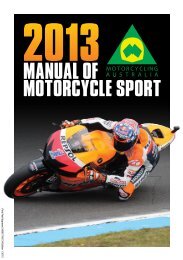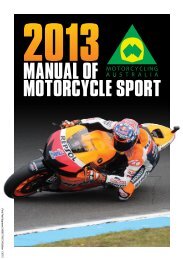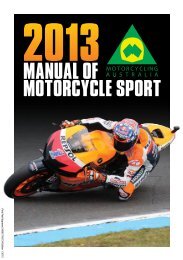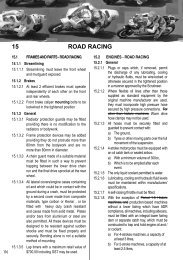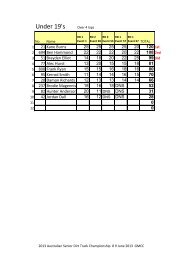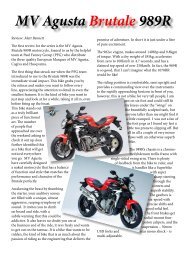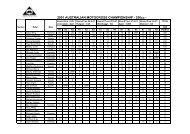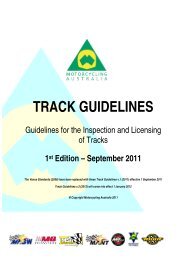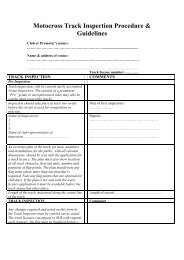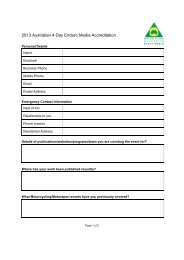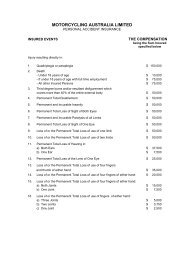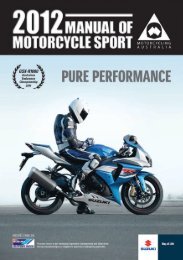2009 Manual of Motorcycle Sport - Motorcycling Australia
2009 Manual of Motorcycle Sport - Motorcycling Australia
2009 Manual of Motorcycle Sport - Motorcycling Australia
- No tags were found...
You also want an ePaper? Increase the reach of your titles
YUMPU automatically turns print PDFs into web optimized ePapers that Google loves.
PHILOSOPHY OF GCR’Senjoy the rideTHE GENERAL COMPETITION RULESTHE PHILOSOPHY AND STRUCTURE OF THE GENERAL COMPETITION RULESNo set <strong>of</strong> Rules can anticipate every issue which mayarise in the conduct <strong>of</strong> a sport, especially one with as widea variety <strong>of</strong> disciplines and competing interests as exist inmotorcycling. The philosophy <strong>of</strong> these Rules is that goodsense, cooperation and a fair and reasonable interpretation<strong>of</strong> reasonable Rules should be more important than “RuleBook Racing”.In Rule Book Racing, if a situation arises, the answer isto be found by looking up the book, not by the exercise <strong>of</strong>independent judgment. If there’s no answer in the book,a new rule has to be devised to “plug the hole”. Rule BookRacing assumes that Controlling Bodies have little or nointerest in working effectively with competitors, with eachother, or with Promoters to benefi t the sport and thosewho participate in it. It also assumes that <strong>of</strong>fi cials haveno common sense or understanding <strong>of</strong> the sport. None <strong>of</strong>these ideas is true or fair.These rules confer on the Controlling Bodies and theirrepresentatives and <strong>of</strong>fi cials discretion in the applicationand interpretation <strong>of</strong> the Rules. It is intended that discretionwill be exercised, as stated in the very fi rst rule in this bookto ensure that competition is safe, free and fair.Offi cials are expected to exercise judgment wiselyand fairly, on the understanding that if they do not,their decisions, other than those made in the heat <strong>of</strong>competition, will be subject to review through protestand appeal. They will be trained and encouraged to takeresponsibility for their actions, and to work in a way whichsupports the underlying philosophy <strong>of</strong> the Rules.Our rules should refl ect the way that the sport is conducted.MA and the State Controlling Bodies (SCBs) have beencareful to ensure that there is a process in place to ensurethat every participant has the opportunity to have their sayin the way these rules are written.We actively seek constructive criticism <strong>of</strong> these Rulesand encourage participants to work through theirrepresentatives to ensure their relevance.STRUCTURE OF MANUAL OF MOTORCYCLE SPORTThis book is divided into 29 chapters.The fi rst 14 chapters apply to all disciplines <strong>of</strong> the sportand the rest to the specifi c disciplines. There will be adegree <strong>of</strong> crossover from the fi rst section to the specifi cdisciplines and some <strong>of</strong> the Rules contained in those fi rstchapters need to be added to or varied according to theneeds <strong>of</strong> a particular discipline.We have attempted to make this edition <strong>of</strong> the book moreuser friendly, reinstating an index and reframing everychapter into a as close to a consistent format as possible.36We have also striven to eliminate any ambiguities andcontradictions.Chapter 1 - Jurisdiction.This chapter states the purposes and principlesunderlying the Rules. The Rules are to be applied fairlyand according to the principles <strong>of</strong> natural justice. TheseRules are binding not only on competitors but also on allControlling Bodies.There is a list <strong>of</strong> defi nitions which may be useful whileusing the rest <strong>of</strong> the Book.Chapter 2 - Administration.This very important chapter sets out the authority <strong>of</strong> theControlling Bodies. It identifi es and empowers the peopleand the instrumentalities through which the ControllingBodies exercise their authority.MA is a member <strong>of</strong> the FIM, a federation <strong>of</strong> the controllingbodies <strong>of</strong> motorcycle sport throughout the world, and MAis a federation <strong>of</strong> which the SCBs are members. Thesignifi cance <strong>of</strong> this that the FIM would not exist withoutthe cooperation and involvement <strong>of</strong> its members, and thesame principle applies to MA.SCBs agree to be bound by the decisions <strong>of</strong> MA as part <strong>of</strong>the agreement they entered into with each other when MAwas formed. The SCBs are, in effect, the owners <strong>of</strong> MA,and their control over MA is exercised through the Board.The Board has the power under the Articles <strong>of</strong> Association<strong>of</strong> MA to make competition Rules.Rule 2.1.2 is a very important rule which typifi es thephilosophy which underpins these Rules. In providingfor the making <strong>of</strong> agreements, the Rules clear the way forresolving differences among Controlling Bodies and withPromoters, by consultation, discussion and agreementrather than by disputation and resort to a strict andlegalistic approach.The rest <strong>of</strong> the chapter identifi es the roles, responsibilitiesand limits <strong>of</strong> authority <strong>of</strong> various key <strong>of</strong>fi cials.Chapter 3 - LicencingThe primary pupose <strong>of</strong> having a licencing regime is toensure the safety <strong>of</strong> competitors.This may be applied through separating less experiencedcompetitiors from ‘old hands’ and, in the case <strong>of</strong> juniorcompetition, to ensure that all riders obtain the benefi ts<strong>of</strong> a structured coaching process.Licence holders may not compete at a level higher thantheir licence.The chapter also sets out the processes by which




